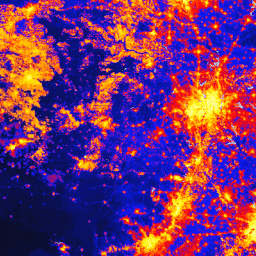
- 데이터 세트 사용 가능 기간
- 2016-01-01T00:00:00Z–2016-12-31T00:00:00Z
- 데이터 세트 제공업체
- 보존 과학 파트너
- Cadence
- 1년
- 태그
설명
전 세계 인간 개조 데이터 세트 (gHM)는 1제곱킬로미터 해상도로 전 세계 육지의 인간 개조 누적 측정값을 제공합니다. gHM 값은 0.0~1.0이며, 수정된 특정 위치(픽셀)의 비율과 특정 유형의 인적 수정 또는 '스트레스 요인'과 관련된 수정 강도를 추정하여 계산됩니다. 2016년경의 5가지 주요 인위적 스트레스 요인은 13개의 개별 데이터 세트를 사용하여 매핑되었습니다.
- 인간 거주지 (인구 밀도, 건물 밀집 지역)
- 농업 (농지, 가축)
- 교통 (주요 도로, 부도로, 양방향 도로, 철도)
- 광업 및 에너지 생산
- 전기 인프라 (전력선, 야간 조명)
방법론에 관한 자세한 내용은 논문을 참고하세요. 이 애셋은 Earth Engine에서 사용할 수 있도록 WGS84로 다시 투영되었습니다.
대역
픽셀 크기
1,000미터
대역
| 이름 | 단위 | 최소 | 최대 | 픽셀 크기 | 설명 |
|---|---|---|---|---|---|
gHM |
km^2 | 0 | 1 | 미터 | 전역 인적 수정 |
이용약관
이용약관
인용
인용:
Kennedy, C.M., J.R. Oakleaf, D.M. Theobald, S. Baruch-Murdo, J. Kiesecker. 2019년. Managing the middle: A shift in conservation priorities based on the global human modification gradient. Global Change Biology 00:1-16. doi:10.1111/gcb.14549
Earth Engine으로 탐색하기
코드 편집기(JavaScript)
var dataset = ee.ImageCollection('CSP/HM/GlobalHumanModification'); var visualization = { bands: ['gHM'], min: 0.0, max: 1.0, palette: ['0c0c0c', '071aff', 'ff0000', 'ffbd03', 'fbff05', 'fffdfd'] }; Map.centerObject(dataset); Map.addLayer(dataset, visualization, 'Human modification');
